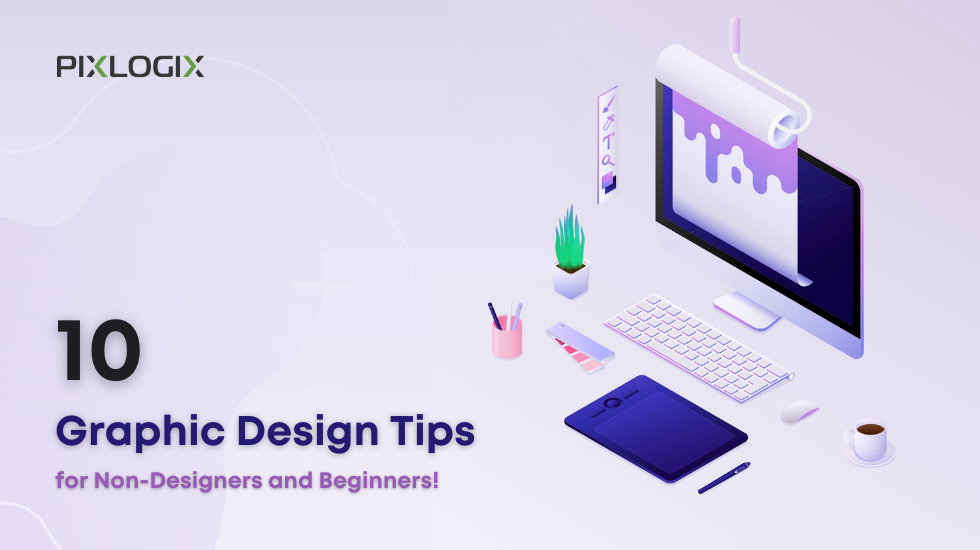In your career, did you ever created designs, being a non-graphic designer? There are several instances of the same:
- Many SEO professionals design banner ads and CTAs
- Social media specialists often design creative elements according to the content of paid ads and organic posts.
- Entrepreneurs out there often design their own website
Visual content is undoubtedly way more engaging and powerful than text-based content. To save a few bucks, several business owners have shifted to DIY graphic design software.
Businesses with huge budget hire graphic designers for their projects. Graphic design has become a core skill for any digital marketer to have in their back pocket.
And it’s feasible to create professional-looking designs even if you have no graphic design training. How?
Here are some tips that will help non-designer and beginners to become a professional
1. Play with colors
If you’re somewhere a bit creative, you might have come across designs with beautiful colors. Colors usually make things more compelling and clear. Therefore, you need to be very smart when playing with colors. Choose better palettes, color combinations to achieve a great design.
Here are a few sources that will help you find the best color palettes available on the web:
- Pigment by Shapefactory
- Coolors
- Adobe Color
2. Add a swipe file
A “swipe file” is a word that comes from the copywriting business, which is certainly applicable in graphic designing too. It refers to examples of good copy that copywriters usually witness while researching. You can do the same.
Search for some examples, store them in your computer, either on drive or dropbox, and then refer to them at the right time. This doesn’t mean you will copy the entire design. But there’s no harm in borrowing a little design excellence.
Suppose, if you’re designing images for Facebook ads, check out the AdEspresso Facebook Ad Gallery for your reference. Design sites like Behance and Dribble can also help you.
3. Protect yourself from Fonts
Fancy fonts might attract you while deciding the content design for your website. You would hundreds of option for the same. But we recommend not to get carried away with these fonts. A font that is visually clear and easy-to-understand is what will drive customers to your website. Ensure you use the best type of font with correct sizing for your target audience.
4. Alignment is a must
In this way, you can present your design elements in the right order, no matter whether the sizes are different. When you align your images in a sophisticated manner, it makes your website’s appearance professional.
5. Adhere to your own design rules
Do you wonder that there’s a rule for better graphic designing? Not at all! Set your own rules and stick to them.
These rules are probably a specific set of lines, texture, colors, and a lot more. If you have a fixed choice for the same, then don’t turn around and do something opposite to it, just for the sake of the experiment.
We recommend you to stay consistent with your design rules, reflecting your consistency in the images that you design.
6. Use icons over texts
In our opinion, icons are like oreganos that can be sprinkled on top of whatever design you’re cooking. Plus, these icons have the power to add extra spice to your design and content presentation, ensuring that the website looks great.
We use icons quite widely to strengthen the content of our blog posts or website design.
7. Keep in mind your target audience
If you’re not designing for your own enjoyment, then probably there’s some set of people whom you’re targetting. Therefore, the target audience plays a key role here. You need to create something that hits the audience’s interest, enabling them to react to the same efficiently.
Connection matters here. Your design shouldn’t be loud or dingy. It won’t help you drive traffic towards your website or interest people to purchase expensive products from you. Plus, you need to be smart enough with your design and the demographic of the target audience.
8. Plan your design
Now you might be wondering, why planning is listed in the mid of tips. Planning is usually done at the beginning of the graphic design process. But when it comes to non-designers and beginners, they usually think of planning once they begin the process.
Ideally, the planning stage shouldn’t be that long, not more than a minute or two. The moment you know what to accomplish before you begin designing, you can easily complete your tasks at a faster pace.
9. Make the most of contrasts
These contrasts help to set the mood of your design as well as make certain elements distinct. There are numerous ways to make a contrast. For instance, you can create contrasting fonts, colors, or even the contrast between the spaces of your design.
You can implement these contrasts in the real-world too. It does make sense. For instance, a person with 7ft height might contrast in public with a general height range of 5-6ft. The same goes for contrasting elements in your design. Adobe colors can greatly help you in this.
10. Rinse and repeat
Suppose, if you’re working on various designs for a website, ad campaign, or any other project. Rinsing and repeating is the best easiest way to accomplish your task. This means copy-paste your design and then just adds the required elements you need. This will ensure the format is the same, no matter whether you change the content or not.
Bottom line
We hope these Graphic design tips will help you become a professional or to reach intermediate level in graphic design process.
